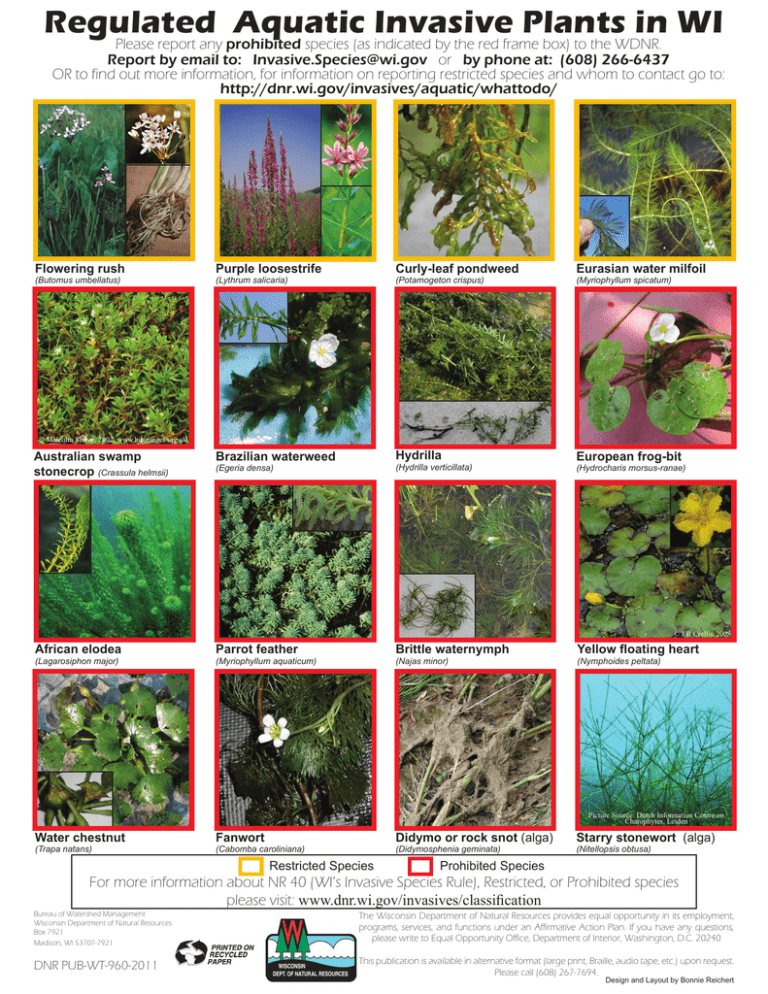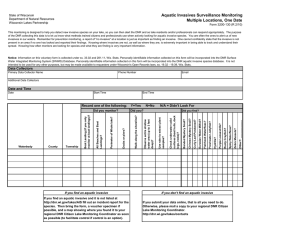Regulated Aquatic Invasive Plants in WI
advertisement

Regulated Aquatic Invasive Plants in WI Please report any prohibited species (as indicated by the red frame box) to the WDNR. Report by email to: Invasive.Species@wi.gov or by phone at: (608) 266-6437 OR to find out more information, for information on reporting restricted species and whom to contact go to: http://dnr.wi.gov/invasives/aquatic/whattodo/ Flowering rush (Butomus umbellatus) Purple loosestrife Curly-leaf pondweed Eurasian water milfoil Brazilian waterweed Hydrilla European frog-bit (Lythrum salicaria) (Potamogeton crispus) (Myriophyllum spicatum) © Malcolm Storey, 2002, www.bioimages.org.uk Australian swamp stonecrop (Crassula helmsii) (Hydrilla verticillata) (Egeria densa) (Hydrocharis morsus-ranae) © J R Crellin 2008 African elodea (Lagarosiphon major) Parrot feather Brittle waternymph (Myriophyllum aquaticum) (Najas minor) Yellow floating heart (Nymphoides peltata) Picture Source: Dutch Information Centre on Charophytes, Leiden Water chestnut (Trapa natans) Fanwort Didymo or rock snot (alga) (Cabomba caroliniana) (Didymosphenia geminata) Restricted Species Starry stonewort (alga) (Nitellopsis obtusa) Prohibited Species For more information about NR 40 (WI’s Invasive Species Rule), Restricted, or Prohibited species please visit: www.dnr.wi.gov/invasives/classification Bureau of Watershed Management Wisconsin Department of Natural Resources Box 7921 Madison, WI 53707-7921 The Wisconsin Department of Natural Resources provides equal opportunity in its employment, programs, services, and functions under an Affirmative Action Plan. If you have any questions, please write to Equal Opportunity Office, Department of Interior, Washington, D.C. 20240 DNR PUB-WT-960-2011 This publication is available in alternative format (large print, Braille, audio tape, etc.) upon request. Please call (608) 267-7694. Design and Layout by Bonnie Reichert Chapter NR 40: Invasive Species Identification Classification and Control Boater & Angler Summary The Invasive Species Rule (Chapter NR 40) went into effect on September 1, 2009. The rule establishes a comprehensive, science-based way to classify and regulate invasive species in Wisconsin. The rule divides species into 2 categories, "Prohibited" and "Restricted,” with different regulations and control requirements. The rule also establishes “Preventative Measures” to show what actions we can take to slow the spread of invasive species. The preventative measures of NR 40, along with the measures required by Act 55, the “No Transport Law” may require changes in boater and angler actions. ← Following the Prevent the Spread guidelines on the left is a great start to following these laws. Additional information and requirements for the Invasive Species Rule are listed below. Prohibited Invasive Species • These species are not yet in the state or only in a few places • These species are likely to cause environmental and/or economic harm • It is still possible to eradicate these species and prevent their spread statewide Regulations: Cannot transport, possess, transfer, or introduce without a permit* Control Authority: Control is required. DNR may order or conduct a control effort Restricted Invasive Species • These species are already widely established in the state • High environmental and/or economic impacts are evident with these species • Complete eradication of these species is unlikely Regulations: Cannot transport, transfer, or introduce without a permit* Possession is allowed except for fish or crayfish Control Authority: Control is encouraged but not required *Any viable part of the species is covered by these regulations. Preventative Measures • Drainage of water from boats and removal of aquatic plants and animals from equipment is required before entering onto a road or coming into the state • The introduction of non-native aquatic plants prohibited • The transport of live fish and eggs are prohibited • You may not use prohibited fish or crayfish as bait For more information, please visit: www.dnr.wi.gov/invasives/classification Or contact the WDNR Invasive Species Project Coordinator at: Email: Invasive.Species@wi.gov or Phone: (608) 266-6437





